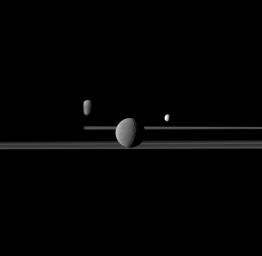The Cassini spacecraft observes three of Saturn's moons set against the darkened night side of the planet.
Saturn is present on the left this image but is too dark to see. Rhea (1,528 kilometers, or 949 miles across) is closest to Cassini here and appears largest at the center of the image. Enceladus (504 kilometers, or 313 miles across) is to the right of Rhea. Dione (1,123 kilometers, or 698 miles across) is to the left of Rhea, partly obscured by Saturn.
This view looks toward the northern, sunlit side of the rings from just above the ringplane.
The image was taken in visible red light with the Cassini spacecraft narrow-angle camera on April 25, 2011. The view was obtained at a distance of approximately 2.2 million kilometers (1.4 million miles) from Rhea and at a Sun-Rhea-spacecraft, or phase, angle of 67 degrees. Image scale is 13 kilometers (8 miles) per pixel on Rhea. The view was obtained at a distance of approximately 3 million kilometers (1.9 million miles) from Enceladus and at a phase angle of 67 degrees. Image scale is 18 kilometers (11 miles) per pixel on Enceladus. The view was obtained at a distance of approximately 3.1 million kilometers (1.9 million miles) from Dione and at a phase angle of 67 degrees. Image scale is 19 kilometers (12 miles) per pixel on Dione.
The Cassini-Huygens mission is a cooperative project of NASA, the European Space Agency and the Italian Space Agency. The Jet Propulsion Laboratory, a division of the California Institute of Technology in Pasadena, manages the mission for NASA's Science Mission Directorate, Washington, D.C. The Cassini orbiter and its two onboard cameras were designed, developed and assembled at JPL. The imaging operations center is based at the Space Science Institute in Boulder, Colo.
For more information about the Cassini-Huygens mission visit http://saturn.jpl.nasa.gov/. The Cassini imaging team homepage is at http://ciclops.org.

 Planetary Data System
Planetary Data System












